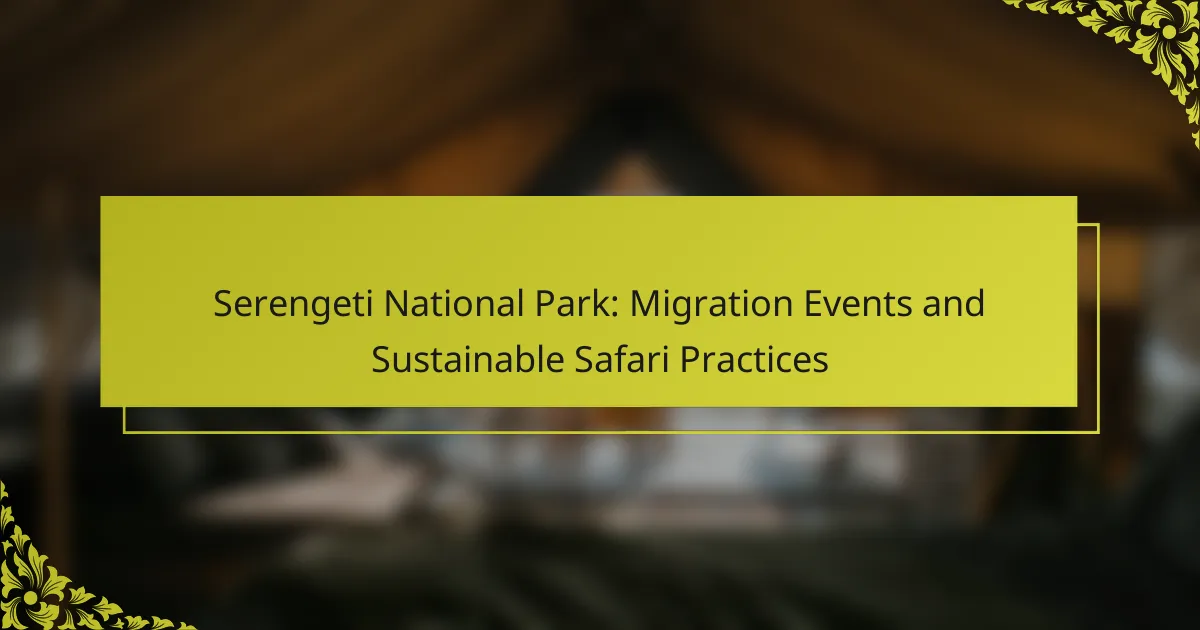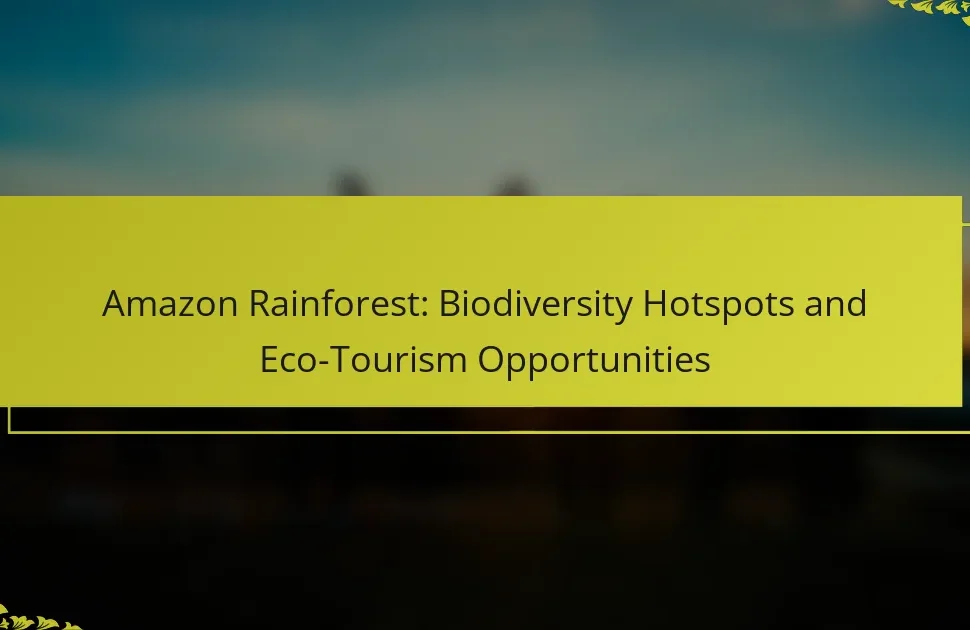Understanding the migration events in Serengeti National Park is essential for appreciating its unique ecosystem. This article explores the Great Migration’s cyclical patterns, the impact of climate change on wildlife movements, and the importance of sustainable safari practices. It highlights conservation efforts that protect species, engage local communities, and enhance visitor experiences while preserving the park’s biodiversity.
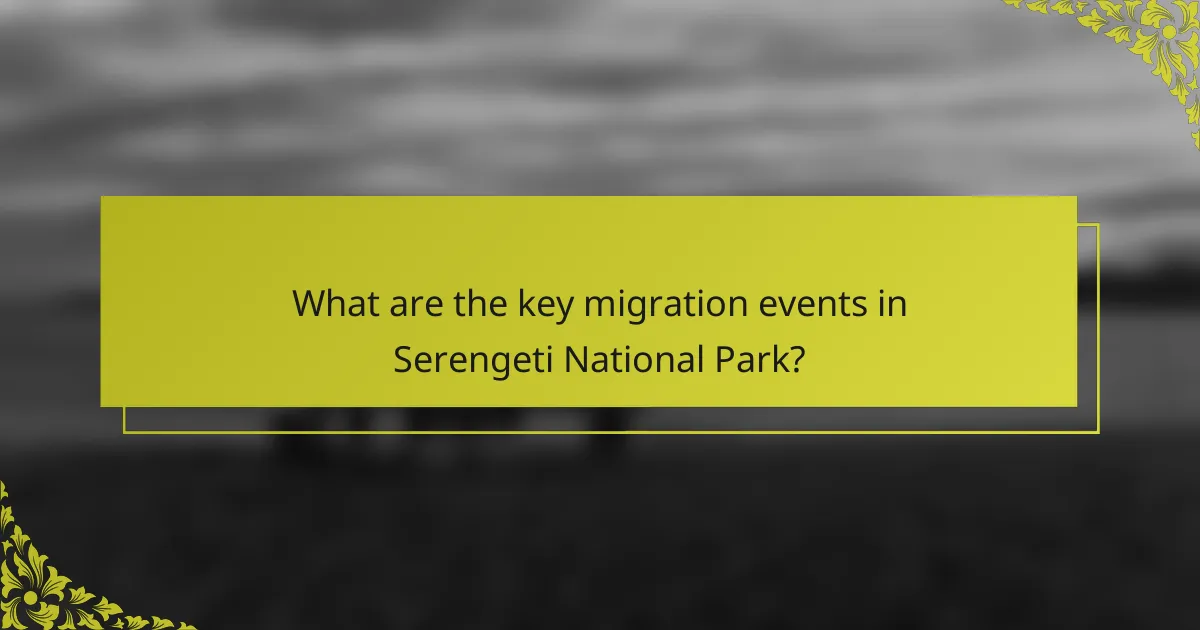
What are the key migration events in Serengeti National Park?
The key migration events in Serengeti National Park include the Great Migration, which features over 1.5 million wildebeest and 200,000 zebras. This annual event occurs in a cyclical pattern influenced by rainfall and grazing conditions.
The migration typically begins in January with calving in the southern Serengeti, followed by movement towards the western corridor around April. By June, herds cross the Grumeti River, facing challenges from crocodiles. In late July to October, they reach the Maasai Mara in Kenya, before returning south in November.
These migration events are crucial for the ecosystem, supporting predator-prey dynamics and nutrient cycling. Sustainable safari practices enhance visitor experiences while preserving these natural processes.
How does the Great Migration impact local ecosystems?
The Great Migration significantly impacts local ecosystems by enhancing biodiversity and nutrient cycling. As millions of wildebeest, zebras, and other herbivores traverse the Serengeti, they graze on grasses, which stimulates new growth. This grazing prevents overgrowth and maintains the savanna ecosystem. Additionally, their movement aids in seed dispersal, promoting plant diversity. Predators, like lions and hyenas, benefit from the migration as it provides a consistent food source, contributing to the balance of the ecosystem. Sustainable safari practices help preserve these natural processes by minimizing human impact and ensuring the continuation of the migration’s ecological benefits.
What species are involved in the migration process?
The migration process in Serengeti National Park primarily involves wildebeest, zebras, and various antelope species. These animals migrate annually in search of fresh grazing grounds and water sources. The wildebeest migration, the largest in the world, features around 1.5 million wildebeest along with thousands of zebras and gazelles. This event showcases the interconnectedness of species and their adaptation to seasonal changes. The migration supports the entire ecosystem, influencing predator movements and plant growth.
When do migration events typically occur?
Migration events in Serengeti National Park typically occur from late June to October. During this period, wildebeests and zebras migrate in search of greener pastures and water sources. The exact timing can vary based on rainfall patterns, but the Great Migration is a well-observed phenomenon. This event supports local ecosystems and attracts numerous tourists, highlighting the importance of sustainable safari practices.
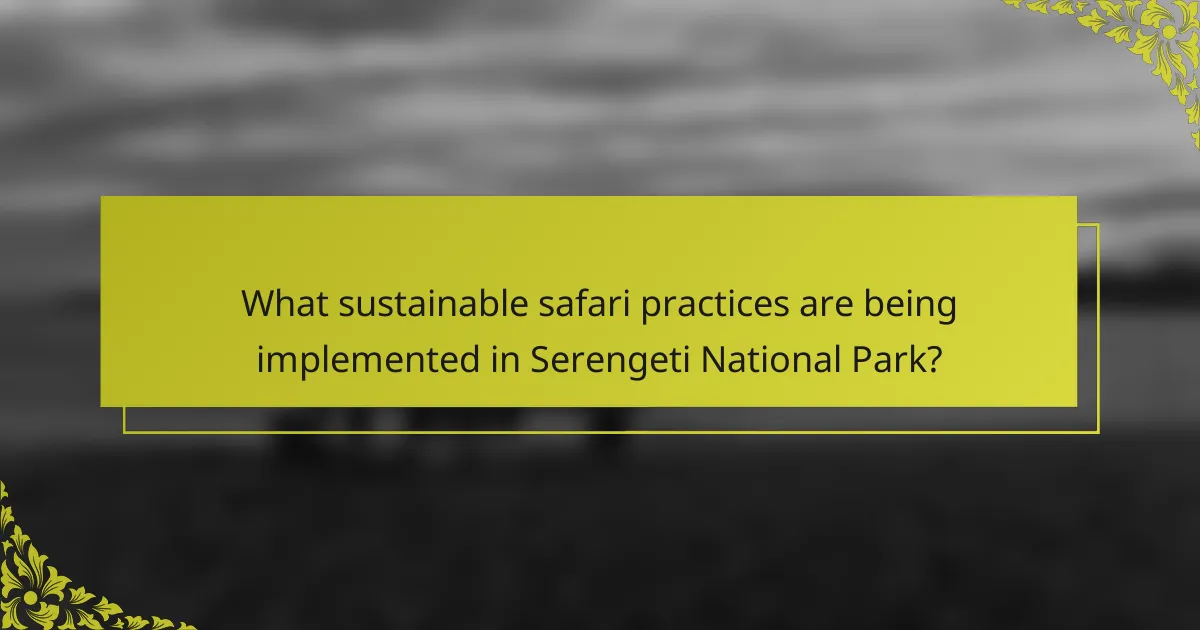
What sustainable safari practices are being implemented in Serengeti National Park?
Sustainable safari practices in Serengeti National Park focus on conservation and community engagement. These include eco-friendly lodges that minimize environmental impact, wildlife monitoring programs to protect species, and community tourism initiatives that benefit local populations. Additionally, educational programs raise awareness about conservation efforts among visitors. These practices help preserve the park’s unique ecosystems and support sustainable tourism.
How do eco-friendly lodges contribute to conservation efforts?
Eco-friendly lodges significantly enhance conservation efforts by promoting sustainable tourism practices. They minimize ecological footprints through renewable energy, waste reduction, and water conservation. These lodges often support local communities, providing economic incentives to protect wildlife and habitats. Additionally, they educate visitors on environmental issues, fostering a culture of conservation. As a result, eco-friendly lodges play a crucial role in preserving the natural beauty of places like Serengeti National Park.
What role do local communities play in sustainable tourism?
Local communities are vital for sustainable tourism in Serengeti National Park. They contribute to conservation efforts and promote responsible safari practices. Engaging locals fosters cultural exchange and economic benefits, ensuring tourism supports community development. Their involvement enhances wildlife protection and habitat preservation, creating a balanced ecosystem.
Which organizations are leading sustainability initiatives in the park?
The African Wildlife Foundation and the Serengeti Conservation Project are leading sustainability initiatives in Serengeti National Park. These organizations focus on wildlife protection and community engagement. The African Wildlife Foundation emphasizes habitat conservation and anti-poaching efforts. The Serengeti Conservation Project promotes sustainable tourism practices and local community involvement. Both organizations aim to balance ecological integrity with economic development in the region.

How does climate change affect migration patterns in Serengeti National Park?
Climate change significantly alters migration patterns in Serengeti National Park. Rising temperatures and changing rainfall affect food availability, prompting wildlife to adapt their migratory routes and timings. As a result, traditional migration events may shift, impacting the ecosystem and safari practices. Changes in grassland growth and water sources directly influence animal movements, necessitating sustainable management strategies to ensure wildlife preservation and visitor experiences.
What are the observable changes in animal behavior due to climate shifts?
Climate shifts lead to observable changes in animal behavior in Serengeti National Park, notably in migration patterns. Animals adjust their migration timing and routes, influenced by altered rainfall and temperature. For example, wildebeest and zebras may migrate earlier or later, impacting their access to food and water. These changes can disrupt traditional grazing areas and affect predator-prey dynamics. Sustainable safari practices can help mitigate these impacts by promoting conservation efforts and responsible wildlife viewing.
Which conservation strategies are being developed to mitigate these effects?
Conservation strategies in Serengeti National Park include anti-poaching measures, habitat restoration, and community engagement. These initiatives aim to protect wildlife and sustain ecological balance. Collaborative efforts with local communities enhance conservation effectiveness. Innovative practices like wildlife corridors are being developed to facilitate animal migration.
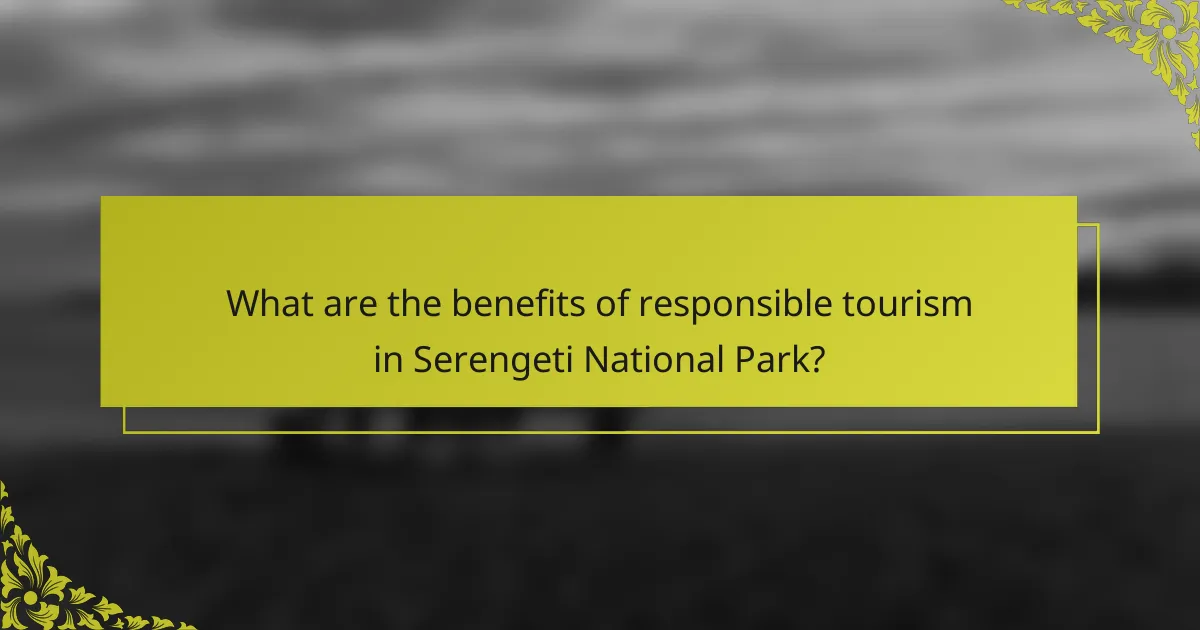
What are the benefits of responsible tourism in Serengeti National Park?
Responsible tourism in Serengeti National Park promotes environmental conservation, supports local communities, and enhances wildlife protection. These practices ensure sustainable safari experiences while preserving the park’s unique biodiversity. By prioritizing eco-friendly initiatives, tourists contribute to the long-term health of the ecosystem and the well-being of residents. This approach fosters a deeper connection between visitors and the natural world, enriching their travel experience.
How can tourists minimize their ecological footprint during safaris?
Tourists can minimize their ecological footprint during safaris by following sustainable practices. Choosing eco-friendly lodges and participating in guided tours reduces environmental impact. Opt for smaller group sizes to limit disturbance to wildlife. Respect wildlife by maintaining a safe distance and avoiding off-road driving. Use reusable water bottles and minimize plastic waste. Supporting local communities through responsible tourism fosters conservation efforts.
What educational opportunities are available for visitors?
Visitors to Serengeti National Park can engage in educational opportunities such as guided tours, workshops, and conservation talks. These programs focus on wildlife migration, ecosystem preservation, and sustainable safari practices. For example, guided tours often include discussions on the Great Migration, highlighting its ecological significance. Workshops may cover photography techniques or wildlife tracking skills, enhancing the visitor experience. Additionally, conservation talks offer insights into ongoing efforts to protect the park’s biodiversity, fostering a deeper understanding of the region’s environmental challenges.
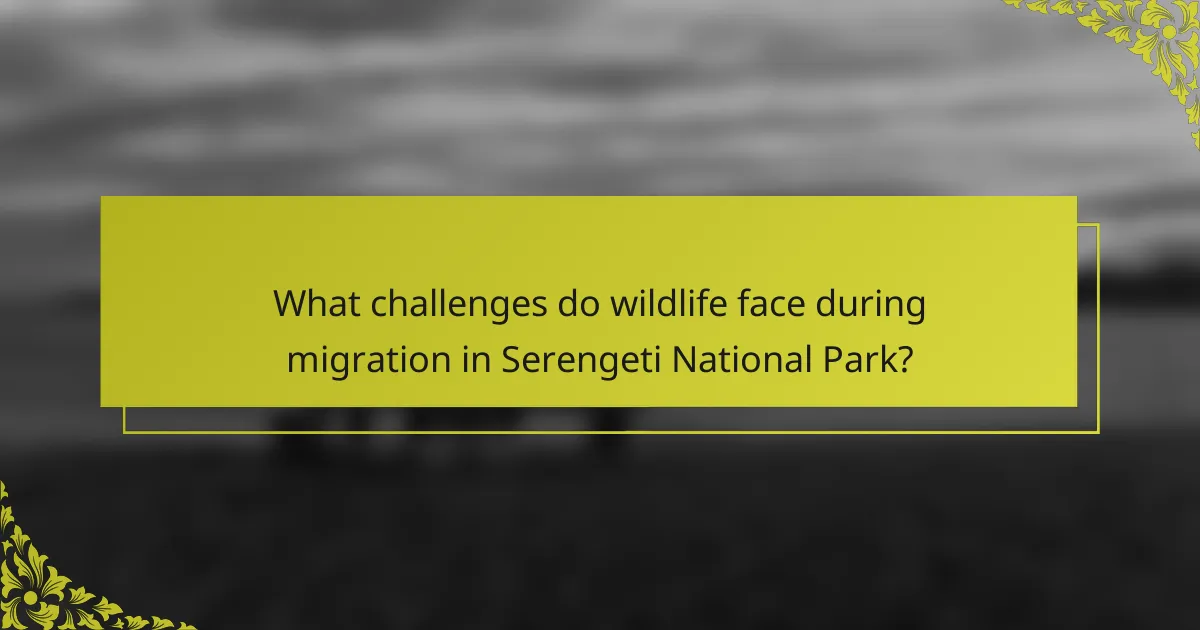
What challenges do wildlife face during migration in Serengeti National Park?
Wildlife in Serengeti National Park face several challenges during migration. These include habitat loss, poaching, and climate change. Habitat fragmentation disrupts migratory routes, making it difficult for animals to access water and food sources. Poaching poses a direct threat to species like elephants and wildebeests. Climate change alters weather patterns, affecting migration timing and availability of resources. As a result, conservation efforts are crucial to ensure the sustainability of these migration events.
How do human activities impact migration routes?
Human activities significantly disrupt migration routes in Serengeti National Park. Urbanization, agriculture, and poaching fragment habitats, hindering wildlife movement. Roads and fences further obstruct traditional paths, leading to increased stress on animal populations. Sustainable safari practices can mitigate these impacts by promoting conservation and responsible tourism.
What measures are in place to protect wildlife during these events?
Measures to protect wildlife during migration events include regulated safari practices, designated wildlife corridors, and continuous monitoring. These strategies minimize human impact, ensuring animals can migrate safely. Additionally, park authorities implement education programs for tourists, promoting responsible behavior in wildlife habitats. Conservation efforts involve collaboration with local communities to foster sustainable practices that benefit both wildlife and people.
Which rare species are particularly vulnerable during migration?
The rare species particularly vulnerable during migration in Serengeti National Park include the African wild dog, black rhinoceros, and various migratory birds. These species face threats from habitat loss, poaching, and climate change during their migratory journeys. The African wild dog, for instance, is critically endangered with a population decline of over 90% in the last century. Conservation efforts focus on protecting their migratory routes and habitats to ensure their survival.
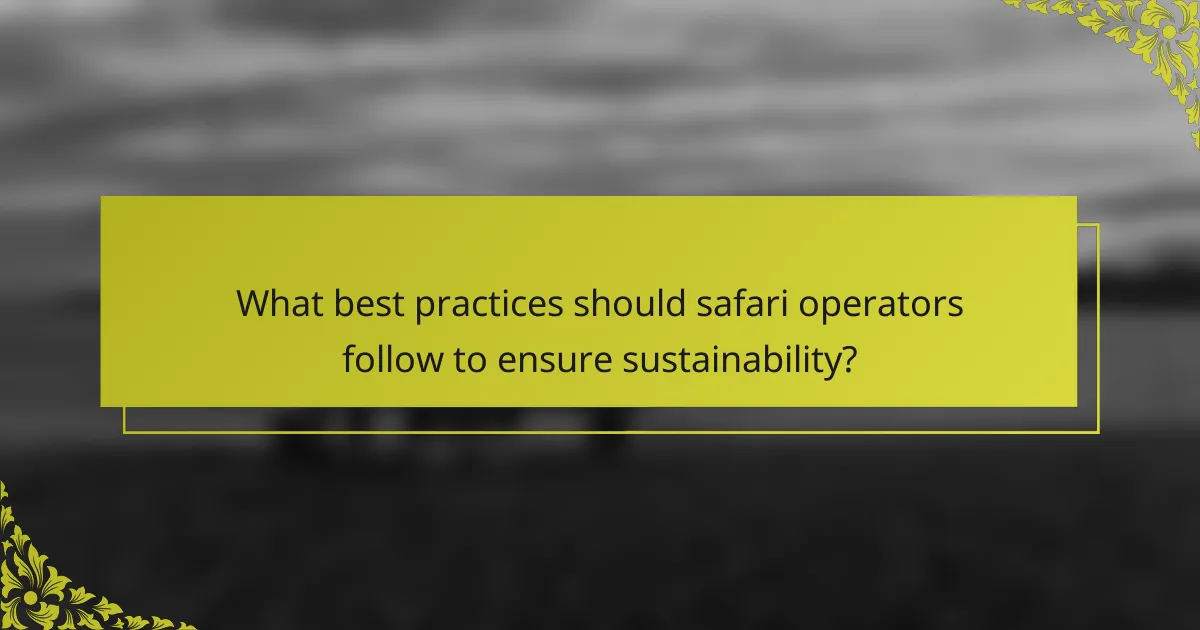
What best practices should safari operators follow to ensure sustainability?
Safari operators should prioritize sustainable practices to protect Serengeti National Park’s ecosystem. Key best practices include minimizing vehicle impact, adhering to designated paths, and limiting group sizes to reduce stress on wildlife. Operators should also engage in conservation efforts, such as supporting local communities and wildlife protection initiatives. Regular training on environmental stewardship for staff enhances awareness and responsibility. Implementing eco-friendly technologies, like solar energy, further promotes sustainability while enriching the safari experience.
How can technology enhance wildlife conservation efforts?
Technology enhances wildlife conservation efforts by improving data collection, monitoring, and engagement. Tools like drones and camera traps provide real-time insights into animal movements and habitat conditions. Geographic Information Systems (GIS) analyze migration patterns, aiding in sustainable safari practices. Mobile apps facilitate community involvement, promoting awareness and responsible tourism in Serengeti National Park. These advancements ensure better protection of wildlife during migration events while supporting eco-friendly tourism initiatives.
What are common pitfalls to avoid in safari operations?
Common pitfalls in safari operations include neglecting wildlife safety, underestimating weather conditions, and failing to adhere to park regulations. These mistakes can disrupt migration events and harm the ecosystem. Additionally, inadequate training for guides can lead to poor visitor experiences and safety risks. Prioritizing sustainable practices is essential to avoid these pitfalls and ensure responsible tourism in Serengeti National Park.
Which certifications indicate a commitment to sustainable practices?
Certifications that indicate a commitment to sustainable practices include the Rainforest Alliance Certification, the Global Sustainable Tourism Council (GSTC) Certification, and the EarthCheck Certification. These certifications reflect adherence to environmental standards and responsible tourism practices. They ensure that safari operators in Serengeti National Park prioritize conservation and community engagement, enhancing both ecological integrity and visitor experience.
